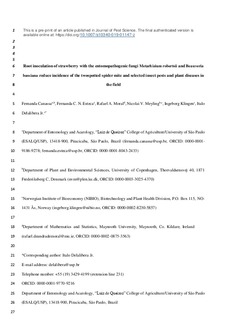Root inoculation of strawberry with the entomopathogenic fungi Metarhizium robertsii and Beauveria bassiana reduces incidence of the twospotted spider mite and selected insect pests and plant diseases in the field
Canassa, Fernanda; Esteca, Fernanda C. N.; Moral, Rafael A.; Meyling, Nicolai Vitt; Klingen, Ingeborg; Delalibera, Italo
Journal article, Peer reviewed
Accepted version
Date
2019-08-14Metadata
Show full item recordCollections
Abstract
The effect of inoculation of strawberry roots by two entomopathogenic fungal isolates, Metarhizium robertsii (ESALQ 1622) and Beauveria bassiana (ESALQ 3375), on naturally occurring arthropod pests and plant diseases was investigated in four commercial strawberry fields during two growing seasons in Brazil. Three locations represented open-field production while strawberries were grown in low tunnels at the fourth location. Population responses of predatory mites to the fungal treatments were also assessed. Plants inoculated by the fungal isolates resulted in significantly fewer Tetranychus urticae adults compared to control plants at all four locations. The mean cumulative numbers ± SE of T. urticae per leaflet were: M. robertsii (225.6 ± 59.32), B. bassiana (206.5 ± 51.48) and control (534.1 ± 115.55) at the three open-field locations, while at the location with tunnels numbers were: M. robertsii (79.7 ± 10.02), B. bassiana (107.7 ± 26.85) and control (207.4 ± 49.90). Plants treated with B. bassiana had 50% fewer leaves damaged by Coleoptera, while there were no effects on numbers of whiteflies and thrips. Further, lower proportions of leaflets with symptoms of the foliar plant pathogenic fungi Mycosphaerella fragariae and Pestalotia longisetula were observed in the M. robertsii (4.6% and 1.3%)- and B. bassiana (6.1% and 1.3%)-treated plots compared to control plots (9.8% and 3.7%). No effect was seen on numbers of naturally occurring predatory mites. Our results suggest that both isolates tested may be used as root inoculants of strawberries to protect against foliar pests, particularly spider mites, and also against foliar plant pathogenic fungi without harming naturally occurring and beneficial predatory mites.
